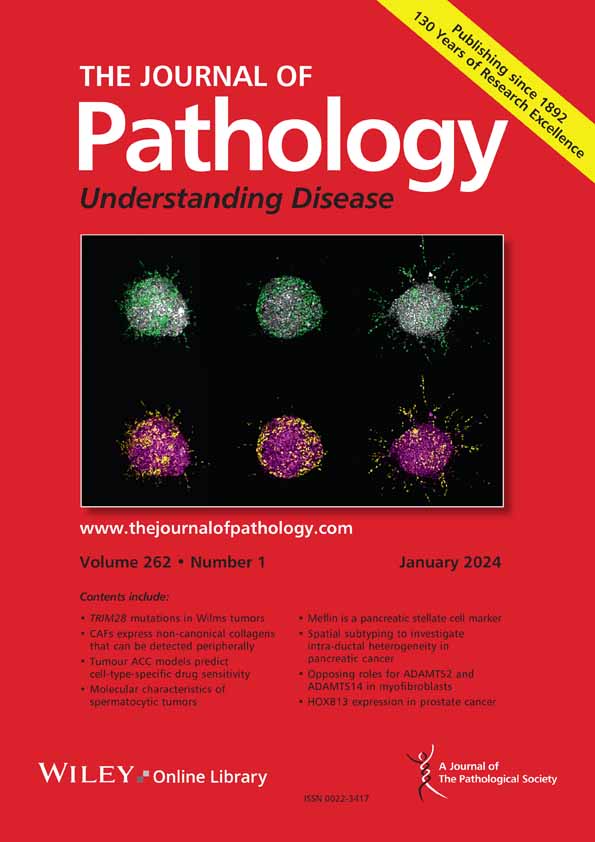Unveiling the intriguing relationship: oncogenic KRAS, morphological shifts, and mutational complexity in pancreatic mucinous cystic neoplasms.
Schulte, Annika Beck, Ralf Marienfeld, Ninel Azoitei, Thomas Barth, Alica Beutel, Vladimir Benes, Markus Büchler, Nadine Gaisa, Katja Kilani, Nathalia Giese, Christoph W Michalski, Peter Möller, Lukas Perkhofer, Tobias Rausch, Stefan Repky, Elodie Roger, Jeanette Scheible, Thomas Seufferlein, Peter Schirmacher, Berger, Thilo Hackert, Alexander Kleger
求助PDF
{"title":"Unveiling the intriguing relationship: oncogenic KRAS, morphological shifts, and mutational complexity in pancreatic mucinous cystic neoplasms.","authors":"Schulte, Annika Beck, Ralf Marienfeld, Ninel Azoitei, Thomas Barth, Alica Beutel, Vladimir Benes, Markus Büchler, Nadine Gaisa, Katja Kilani, Nathalia Giese, Christoph W Michalski, Peter Möller, Lukas Perkhofer, Tobias Rausch, Stefan Repky, Elodie Roger, Jeanette Scheible, Thomas Seufferlein, Peter Schirmacher, Berger, Thilo Hackert, Alexander Kleger","doi":"10.1002/path.6397","DOIUrl":null,"url":null,"abstract":"<p><p>Pancreatic ductal adenocarcinoma (PDAC) often arises from preexisting cystic lesions such as intraductal papillary mucinous neoplasms (IPMN) and mucinous cystic neoplasms (MCN). This study investigated the molecular heterogeneity and mutational landscape of MCN in relation to PDAC, highlighting the significance of KRAS mutations in tumor progression. Utilizing targeted next-generation sequencing on low-grade MCN and invasive PDAC samples, we identified a substantial overlap in mutational profiles, particularly mutations in KRAS, TP53, and FBXW7. Specifically, 69.2% of MCN exhibited somatic mutations, with KRAS mutations being a predominant oncogenic driver. The characterization of mutant versus wildtype KRAS variant allele frequencies (VAF) indicated higher mutation levels in PDAC compared to MCN, suggesting an evolutionary trajectory toward malignancy. Further histological analysis of 12 additional MCN cases revealed significant intratumor heterogeneity, with variant KRAS mutation distributions correlating with distinct cellular morphologies and dysplastic features. Additionally, we explored the potential of liquid biopsies, demonstrating a concordance rate of 71.4% for KRAS mutation detection in circulating tumor DNA (ctDNA) relative to tissue biopsies across cohorts. Our findings underscore the relevance of evaluating KRAS mutations-herein referred to as VAF per microdissected region-as they relate to histopathological markers of dysplasia, contributing to improved stratification of pancreatic lesions and facilitating personalized treatment strategies. In conclusion, this comprehensive analysis of MCN highlights the importance of KRAS as a crucial biomarker for both malignant progression and therapeutic decision-making in pancreatic pathology. Ultimately, our study suggests that characterizing the mutational landscape and histological features of MCN can enhance early detection and intervention strategies for at-risk patients. © 2025 The Author(s). The Journal of Pathology published by John Wiley & Sons Ltd on behalf of The Pathological Society of Great Britain and Ireland.</p>","PeriodicalId":232,"journal":{"name":"The Journal of Pathology","volume":" ","pages":""},"PeriodicalIF":5.6000,"publicationDate":"2025-02-05","publicationTypes":"Journal Article","fieldsOfStudy":null,"isOpenAccess":false,"openAccessPdf":"","citationCount":"0","resultStr":null,"platform":"Semanticscholar","paperid":null,"PeriodicalName":"The Journal of Pathology","FirstCategoryId":"3","ListUrlMain":"https://doi.org/10.1002/path.6397","RegionNum":2,"RegionCategory":"医学","ArticlePicture":[],"TitleCN":null,"AbstractTextCN":null,"PMCID":null,"EPubDate":"","PubModel":"","JCR":"Q1","JCRName":"ONCOLOGY","Score":null,"Total":0}
引用次数: 0
引用
批量引用
Abstract
Pancreatic ductal adenocarcinoma (PDAC) often arises from preexisting cystic lesions such as intraductal papillary mucinous neoplasms (IPMN) and mucinous cystic neoplasms (MCN). This study investigated the molecular heterogeneity and mutational landscape of MCN in relation to PDAC, highlighting the significance of KRAS mutations in tumor progression. Utilizing targeted next-generation sequencing on low-grade MCN and invasive PDAC samples, we identified a substantial overlap in mutational profiles, particularly mutations in KRAS, TP53, and FBXW7. Specifically, 69.2% of MCN exhibited somatic mutations, with KRAS mutations being a predominant oncogenic driver. The characterization of mutant versus wildtype KRAS variant allele frequencies (VAF) indicated higher mutation levels in PDAC compared to MCN, suggesting an evolutionary trajectory toward malignancy. Further histological analysis of 12 additional MCN cases revealed significant intratumor heterogeneity, with variant KRAS mutation distributions correlating with distinct cellular morphologies and dysplastic features. Additionally, we explored the potential of liquid biopsies, demonstrating a concordance rate of 71.4% for KRAS mutation detection in circulating tumor DNA (ctDNA) relative to tissue biopsies across cohorts. Our findings underscore the relevance of evaluating KRAS mutations-herein referred to as VAF per microdissected region-as they relate to histopathological markers of dysplasia, contributing to improved stratification of pancreatic lesions and facilitating personalized treatment strategies. In conclusion, this comprehensive analysis of MCN highlights the importance of KRAS as a crucial biomarker for both malignant progression and therapeutic decision-making in pancreatic pathology. Ultimately, our study suggests that characterizing the mutational landscape and histological features of MCN can enhance early detection and intervention strategies for at-risk patients. © 2025 The Author(s). The Journal of Pathology published by John Wiley & Sons Ltd on behalf of The Pathological Society of Great Britain and Ireland.


